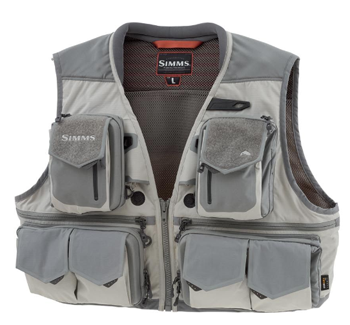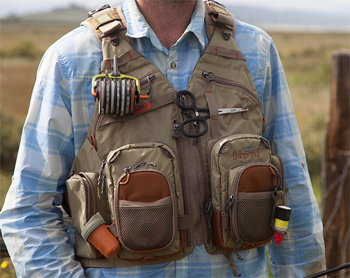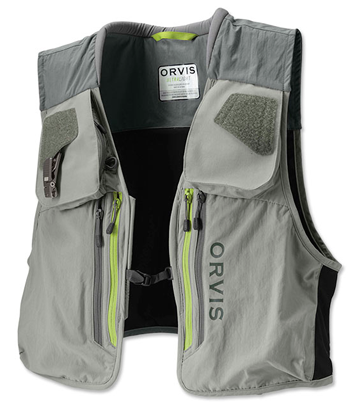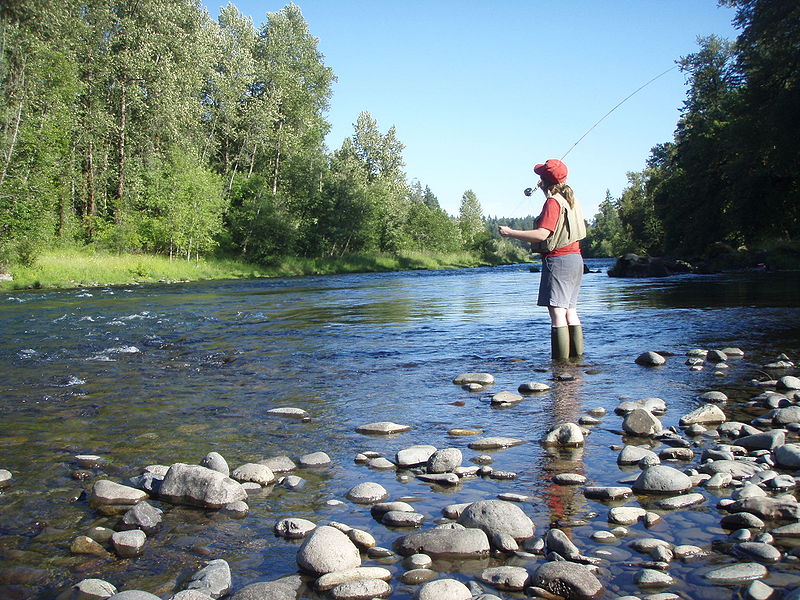[dropcap]I[/dropcap]n 25 years of fishing South Florida on foot, in bay boats and aboard skiffs – fishing for all that swims in canals, Atlantic Ocean and the Gulf of Mexico, Everglades National Park, and the Florida Keys, I only saw professional photographers with fly fishing type vests.
My closet stored fishing vest, of Western Pennsylvania origin, didn’t survive water damage mold from three 2005 hurricanes in Florida, Katrina, Wilma, and glancing blow from Rita. Not much did age past those respective encounters in my brother’s and my first floor, Fort Lauderdale apartment. It was summer minus about a month without electricity.
I bought one, but dismissed layered bulk
I’d forgotten about fishing vests, but when I moved to the foothills of the Appalachian mountains in North Georgia, trout turned my engine on, and I coveted a trout fishing vest – they looked sooo cool.

Simms’ G3 Guide Fishing Vest $249.95
Recently, while fly fishing on a long, mid-summer temperature day that visited our climate changing in very early spring, I became burdened fording the streams and wadeable portions of the “Hootch” (Chattahoochee River). I felt like a peasant hauling cordwood. It detracted from my getting into that “all about now place” where yesterday and tomorrow have no meaning.
That night, with a sore back and Angie rubbing it with some concoction from the “old country,” I decided to do an audit of just what was it in that vest. Maybe someone put an anvil in it? Hey, it would have fit.
My mistake was buying a very expensive fly fishing vest made out of what seemed like Duluth Trading Company quality work pants material, which, as you know, can withstand small arms fire.
The vest itself had too many zippered and velcro flap pockets. Some pockets had pockets within pockets. Too, there were rings to clip things onto either attached directly or the bungee-like cord type, and a lanyard came with it and it had enough mini-tools to interest a “tinkerer.”
Angie couldn’t stop laughing when the contents were on the floor.
The stash took up about four square feet – spread out as if a crime scene
All laid out on the floor, it included, among other more fishy things, $9 in crumpled bills and enough coins to fill a coffee cup, remnants of candy bars, some shriveled stuff we guessed to be fruit, and several birds nests of monofilament clippings (Angie praised me for that).
Amazingly, the cell phone I thought I’d lost and claimed replacement cost for on my insurance policy (I needed to make AT&T amends) was wedged in a pocket within a pocket. Also, several previously wet and then dried pieces of paper were glued together (maybe maps) along with what looked like biz cards – all of it more than half of the displayed evidence.
The fishy stuff was a lot of didn’t know I had stuff or never used tools. For example, a pair of pliers with whatchamacallit blades capable of cutting prison fence wire or surgically removing a digit.
We couldn’t weigh everything but the stuff I added to my garage toolbox made it significantly heavier. The things I put in the trash slumped the plastic liner noticeably.

Fishpond also has several quality fly fishing vests.
I couldn’t immediately part with my expensive, bulletproof fishing vest, but eventually did as a nephew gift. He was in my size department and needed one. I warned him about the vest’s hidden storage problems and, possibly, an anvil we couldn’t find.
I didn’t want my born-again spartan commitment to a fly fishing vest and accessories storage to be a constant field problem
I had some built-in space advantages that would be helpful – most of my attractor size flies are tubes and can be kept in a single pocket, and all the hooks put back in their original packs with tapered leaders. Those attach to tippet rings that connects to whatever tippet and/or dropper you want to attach to it. Those packets take up hardly any space.
The only problem with my search for a lighter, more disciplined vest was that sparse and inexpensive meant big box store. My walk through Walmart, always of circus value, provided only one option, a fishing vest with a cloth-thread count only good enough for a pillow, zippers that fail while examining, velcro pocket closures that only a weightlifter could disengage, and sewn thread leaking from every orifice. No thanks.
The better version vests found in fly shops and at Cabela’s-like stores had lighter vest products, but not to my liking and had the same stack stuff up on itself size pockets – just less of them or the vests were mostly for kids, but some were okay.
Then, serendipity and vindication. I’m not a curmudgeon

Orvis’ Ultralight Fishing Vest – Sizes S to XXL. MSRP $140
Last Sunday, I happened to be reviewing my industry feeds and story links and voilà, I was pronounced sane right on the spot.
Hatch magazine (June 12, 2018), one of the best niche world of fly fishing publications, had an article by a fly fisher who claimed spiritual awakening in his quest for a lighter, better fishing vest. He had found it in an Orvis rendition.
The author, Spencer Durrant, hit all the right notes about what is so pain in the arse about fly fishing vests, especially so for those of us finding no remission in fanny/hip packs.
About Spencer Durrant. He is a fly fishing writer and outdoors columnist from Utah. He’s the Owner/CEO of Cutthroat Creative Media and Managing Editor of The Modern Trout Bum (a good site).
Here’s another article about vests . . .
So, what would be in my vest that’s odd, crucial to me, but probably not to you?
1. A cheap, fold up poncho (throw away value – comes in a glasses case size holder).
2. Tie-Fast tool: Makes a Nail Knot, Snell a Knot, tippet to hook knot (better than a Clinch Knot), join similar or dissimilar lines knot (better than a Blood Knot), and attach tippets to a tippet ring knot (strong and quick to tie).
3. Glasses wipes packs (about 10 – you can buy them 100 for $5, or less at big box stores).
4. A small, waterproof but powerful LED flashlight (Google waterproof tactical flashlight).
5. Pocketknife, multi-tool. ($50-$100)
6. A roll up and fold up homemade seine (screen for critters).
7. Truck keys.
8. Not telling.
Featured Image by Pete Forsyth, fly fishing the South Santiam River in Oregon. A commons image.


